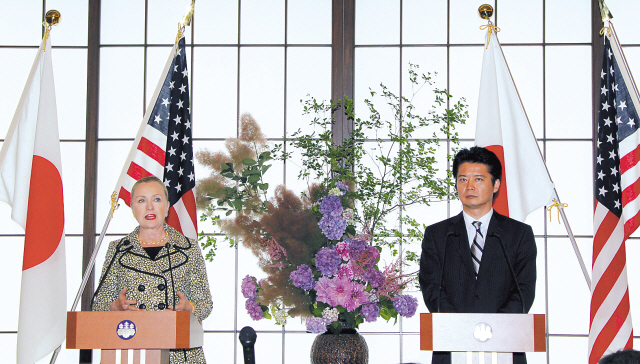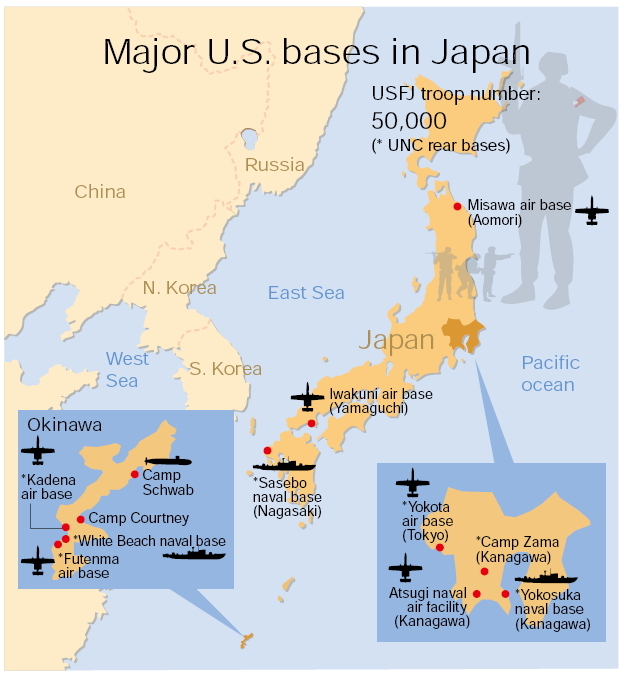U.S.-Japan alliance grows for Asia-Pacific security balance
By Korea HeraldPublished : July 8, 2012 - 18:39
Japan’s military buildup to play crucial role in countering China
This is the third in the series of articles on America’s refocus on the Asia-Pacific region and the possible impact on its alliances with South Korea and Japan. ― Ed.
Japan is more aggressively pushing to become a “normal state” with a full-fledged military as China increasingly flexes its naval might and North Korea tests its patience with missile and nuclear tests.
Japan’s increasing assertiveness comes as the U.S. is deepening its strategic engagement in the Asia-Pacific to maintain its preeminence challenged by China’s rise.
Despite its constitutional ban on war-related activities, the Japanese prime ministerial panel has reportedly claimed the need to recognize Japan’s right for collective self-defense ― the use of force to respond to an attack on an ally, namely the U.S.
Last month, Japan’s legislature passed the first revision in 34 years to the Atomic Energy Basic Act including “national security” among its goals, paving the way for the archipelago state’s nuclear armament.
These moves have prompted protests from its neighbors that still have bitter memories of Japan’s wartime atrocities.
But they are seen as a positive development for the U.S. as Japan’s strategic enhancement may help maintain its primacy in the changing security landscape in the region.
This is the third in the series of articles on America’s refocus on the Asia-Pacific region and the possible impact on its alliances with South Korea and Japan. ― Ed.
Japan is more aggressively pushing to become a “normal state” with a full-fledged military as China increasingly flexes its naval might and North Korea tests its patience with missile and nuclear tests.
Japan’s increasing assertiveness comes as the U.S. is deepening its strategic engagement in the Asia-Pacific to maintain its preeminence challenged by China’s rise.
Despite its constitutional ban on war-related activities, the Japanese prime ministerial panel has reportedly claimed the need to recognize Japan’s right for collective self-defense ― the use of force to respond to an attack on an ally, namely the U.S.
Last month, Japan’s legislature passed the first revision in 34 years to the Atomic Energy Basic Act including “national security” among its goals, paving the way for the archipelago state’s nuclear armament.
These moves have prompted protests from its neighbors that still have bitter memories of Japan’s wartime atrocities.
But they are seen as a positive development for the U.S. as Japan’s strategic enhancement may help maintain its primacy in the changing security landscape in the region.

“In light of China’s rise, it makes good strategic sense for Japan to build up its military capabilities and act more like a normal state in the Asia-Pacific region. The U.S. will certainly welcome this development,” John J. Mearsheimer, a leading realism theorist of international relations, told The Korea Herald via email.
“In fact, Washington has been pushing Japan to improve its military forces and act more assertively, because the U.S. is increasingly worried about growing Chinese power, and wants Japan to play a key role in checking China if it adopts an overly ambitious foreign policy,” Mearsheimer, a professor at the University of Chicago, said.
Commensurate with its military and economic power, Japan’s political right has stressed the need for their country to assume a greater regional and global role beyond the defense of its own land.
They have argued that the interpretation of Article 9 in the country’s so-called pacifist constitution should be altered to allow Japan’s Self-Defense Forces to actively engage in global security operations led by its ally U.S.
Such arguments have gained greater support due to continuing threats from China’s military buildup and an increasingly bellicose North Korea.
Some observers said that Japan’s pursuit of a stronger military also derives from its efforts to shore up its global status, which has apparently declined due to a prolonged economic slump and political instability.
U.S.-Japan alliance deepens
As the U.S. has been shifting its military and diplomatic priorities toward the economically vibrant region, its alliance with Japan, along with its one with South Korea, will continue to be the core of its strategy to maintain primacy in the region.
“Washington hopes to work with China’s neighbors to put together a balancing coalition that will contain China and prevent it from dominating Asia the way the U.S. dominates the Western Hemisphere,” said Mearsheimer.
On the surface, the alliance between the U.S. and Japan appears to have worsened in recent years due to a long-standing controversy over the relocation of the Futenma airbase in Okinawa.
But this would not undermine the core of the alliance between the two countries that share security interests and values of democracy, and take initiatives against global terrorism and proliferation of weapons of mass destruction, experts pointed out.
“People should not misconstrue a long-running local dispute over how to close one Marine air base with the durability and capability of that vital alliance,” said Patrick M. Cronin, senior director of the Asia Program at the Center for a New American Security.
After the Democratic Party of Japan took power in 2009, ending a half-century of almost unbroken conservative rule, the alliance appeared to have deteriorated with the Tokyo leadership pursuing a closer yet “equal” relationship.
But it has apparently re-prioritized its relationship with Washington as it recognized growing security challenges from China and North Korea.
Amid its strategic pivot toward Asia, the U.S. is likely to escalate its calls for the Asian ally to contribute more to maintaining stability in the region.
Japan also wanted to increase its military role in the region and beyond. But it has been fettered by the pacifist constitution.
The law prohibits Japan from going to war and having any potential war materials, and engaging in collective defense action, which makes it difficult to help support its ally U.S. even if it is attacked. Right-wingers have sought to rewrite the law or tried to alter the interpretation of it to expand the role of the Self-Defense Forces.
The deepening of the military alliance is also crucial for Tokyo, which has been engaged in an increasingly strident territorial disputes with Beijing over a set of islands in the East China Sea, which are called Senkaku in Japanese and Diaoyu in Chinese.
Japan is now considering nationalizing the islands to manage them “stably and peacefully.” This move has sparked strong opposition from China and Taiwan.
As the U.S. is now fleshing out the AirSea Battle concept apparently to counter China’s “anti-access/area denial” capabilities, Japan is also expected to play a crucial role in making it more concrete and viable given its close missile defense cooperation with the U.S., observers said.
The concept Washington put forward earlier this year is to conduct integrated aerial and naval operations across all domains such as air, maritime, space and cyberspace to neutralize increasingly sophisticated military techniques of potential adversaries.
“Japan’s role is expected to be crucial (for the AirSea Battle concept) given its air and naval power in addition to U.S. troops in Japan consisting mainly of marines, naval and air units,” said Nam Chang-hee, political science professor at Inha University.
“Japan is actively supporting America’s move to strengthen the bilateral military cooperation as it expands its naval assets such as submarines. The two countries are becoming united in the alliance.”
Seeking to tackle its national debt, Washington has been striving to form a security network with its allies including South Korea and Japan, and other partners such as Vietnam, which wants a greater U.S. presence due to China’s aggressive foreign policy.
At the same time, Washington also hopes to engage Beijing in its diplomatic activities and a variety of multilateral cooperative mechanisms to encourage it to play a “positive” role in the regional security architecture.
Challenges in forging triangular ties
U.S. Secretary of State Hillary Clinton on her tour of eight countries in Asia, Europe and the Middle East, plans to visit Laos for the first time in 57 years as America’s top diplomat. Last year, she also visited Myanmar. The two Southeast Asian states located close to China are of great geostrategic interest to the U.S..
The U.S. has long strived to encourage South Korea and Japan to push aside their historical conflicts and move forward to have stronger trilateral cooperation to better deal with Pyongyang and apparently counterbalance China.
But historic animosity turned out to be more challenging than it thought it would be.
For months, Seoul and Tokyo had sought to ink a rudimentary military intelligence-sharing pact in efforts to lay the groundwork for deepened defense cooperation.
But the efforts faltered due to strong opposition from some political circles and civil society that have criticized the Seoul government for pushing for the deal without forming public consensus.
For South Korea, the trilateral cooperation is burdensome given that China is its largest trading partner, and that Beijing has a significant leverage to persuade North Korea from renouncing its nuclear ambitions.
Tensions in bilateral alliances were also one of the hurdles for the three-way security ties.
Like the alliance between South Korea and the U.S., America’s alliance with Japan has suffered friction due to crimes and accidents involving U.S. service members, and environmental damage caused by U.S. troop facilities.
Public antipathy toward U.S. troops has continued particularly in Okinawa due to crimes and accidents including a 2004 plane crash at a university campus.
The country’s southernmost area has more than 60 percent of the U.S. troops in Japan due to its strategic location that enables rapid deployment to the Korean Peninsula, the Taiwan Straits and other parts of areas in the region, in case of contingencies.

The relocation of the Futenma base along with the U.S. troop realignment has been a tough nut to crack for both countries. Delinking the two issues, Washington and Tokyo agreed in April to withdraw some 9,000 marines from Okinawa.
“For decades, we have placed a great burden on the people of Okinawa by concentrating the majority of military forces there,” said Cronin of the CNAS.
“Moving some of our forces in Japan to other parts of the Asia-Pacific region not only makes our bases more politically sustainable, but they also help to make our forces less vulnerable to attack.”
Impact of U.S.-Japan alliance on Korean Peninsula
The U.S.-Japan alliance is one of the three pillars defending South Korea. The two others are South Korea’s alliance with the U.S. and its own military might, according to security experts.
“Troops in Japan are to provide significant logistical and intelligence support in the event of contingencies on the peninsula,” said Nam of Inha University. “Should any of the three pillars fail to work, there will be serious problems in our deterrence as well as war-managing capabilities.”
There are seven rear bases of the U.N. Command in Japan that will help support South Korea in case of a war on the peninsula. The U.S.-led UNC is a unified command structure for multinational military forces, which was established after the U.N. adopted its Security Council Resolution 84 on July 7, 1950.
The UNC bases include Camp Zama near Tokyo; Kadena Air Base, the hub of America’s airpower in the Asia Pacific; and Yokosuka Naval Base, the largest U.S. Navy installations in the Western Pacific.
The use of the bases is governed by a status-of-forces agreement between the UNC and the Tokyo government.
By Song Sang-ho (sshluck@heraldcorp.com)
-
Articles by Korea Herald










![[Kim Seong-kon] Democracy and the future of South Korea](http://res.heraldm.com/phpwas/restmb_idxmake.php?idx=644&simg=/content/image/2024/04/16/20240416050802_0.jpg&u=)








![[Today’s K-pop] BTS pop-up event to come to Seoul](http://res.heraldm.com/phpwas/restmb_idxmake.php?idx=642&simg=/content/image/2024/04/17/20240417050734_0.jpg&u=)